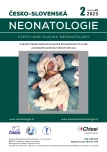-
Medical journals
- Career
Systems for automatic oxygen dosing during artificial lung ventilation
Authors: P. Kudrna 1,2; L. Tejkl 2
Authors‘ workplace: Klinika gynekologie, porodnictví a neonatologie, 1. LF UK a VFN, Praha 1; Katedra biomedicínské techniky, Fakulta biomedicínského inženýrství ČVUT, Praha 2
Published in: Čes-slov Neonat 2023; 29 (2): 121-124.
Category: Contributions on respiratory problems of preterm newborns
Overview
Modern technology has made it possible to automatically control the oxygen levels in the ventilation mixture provided to patients. The concentration of inspired oxygen can be regulated based on real-time information from the pulse oximeter built into the lung ventilator. This feedback control is called automatic closed loop, which requires an electronically controlled gas mixer. Blood oxygen saturation is measured using Masimo or Nellcor pulse oximetry technology.
The paper provides further details on the types of automatic closed loop control algorithms and the clinically available technologies. Studies have shown that automatic closed loop systems more efficiently maintain normal blood oxygen levels than manual fraction of inspired oxygen adjustment. While automatic closed loop systems can quickly resolve hypoxemic episodes, they cannot prevent them entirely.
Keywords:
oxygen fraction, feedback, automatic oxygen regulation, patient in the loop, lung ventilation
Sources
- White G. Equipment theory for respiratory care. 5th edition. Hampshire: Cengage Learning, 2015.
- Dani C. Automated control of inspired oxygen (FiO2) in preterm infants: literature review. Pediatr Pulmonol 2019; 54(3): 358–363.
- Poets CF, Franz AR. Automated FiO2 control: nice to have, or an essential addition to neonatal intensive care? Arch Dis Child Fetal Neonatal Ed 2017; 102(1): F5–F6.
- Sola A, Golombek SG, Montes Bueno MT, et al. Safe oxygen saturation targeting and monitoring in preterm infants: can we avoid hypoxia and hyperoxia? Acta Paediatr 2014; 103(10): 1009–1018.
- Hütten MC, Goos TG, Ophelders D, et al. Fully automated predictive intelligent control of oxygenation (PRICO) in resuscitation and ventilation of preterm lambs. Pediatr Res 2015; 78(6): 657–663.
- Maiwald CA, Niemarkt HJ, Poets CF, et al. Effects of closed-loop automatic control of the inspiratory fraction of oxygen (FiO2-C) on outcome of extremely preterm infants – study protocol of a randomized controlled parallel group multicenter trial for safety and efficacy. BMC Pediatr 2019; 19(1): 363.
- Dargaville P, Franz A, Poets CF, et al. Automated oxygen control in the preterm infant: automation yes, but we need intelligence. Arch Dis Child Fetal Neonatal Ed 2019; 104(4): F366–F371.
- Sturrock S, Williams E, Dassios T, et al. Closed loop automated oxygen control in neonates: a review. Acta Paediatr 2020; 109(5): 914–922.
- Van Zanten HA, Kuypers LAM, Stenson BJ, et al. The effect of implementing an automated oxygen control on oxygen saturation in preterm infants. Arch Dis Child Fetal Neonatal Ed 2017; 102(5): F395–F399.
- Schwarz CE, Kidszun A, Biederet NS, et al. Is faster better? A randomised crossover study comparing algorithms for closedloop automatic oxygen control. Arch Dis Child Fetal Neonatal Ed 2020; 105(4): 369–374.
- Hallenberger A, Poets CF, Horn W, et al. Closed-loop automatic oxygen control (CLAC) in preterm infants: a randomized controlled trial. Pediatrics 2014; 133(2): e379–e385.
- Salverda HH, Cramer SJE, Witlox RSGM, et al. Automated oxygen control in preterm infants, how does it work and what to expect: a narrative review. Arch Dis Child Fetal Neonatal Ed 2021; 106(2): 215–221.
- Tejkl L. Optimalizace automatického řízení oxygenace u nezralých novorozenců [disertační práce]. Katedra biomedicínské techniky. Fakulta biomedicínské techniky, ČVUT. Praha, 2020
- Gajdos M, Waitz M, Mendler MR, et al. Effects of a new device for automated closed loop control of inspired oxygen concentration on fluctuations of arterial and different regional organ tissue oxygen saturations in preterm infants. Arch Dis Child Fetal Neonatal Ed 2019; 104(4): F360–F365.
- Dargaville PA, Fathabadi OS, Gemma K, et al. Development and preclinical testing of an adaptive algorithm for automated control of inspired oxygen in the preterm infant. Arch Dis Child Fetal Neonatal Ed 2017; 102(1): F31–f36.
- Dargaville PA, Marshall AP, McLeod L, et al. Automation of oxygen titration in preterm infants: current evidence and future challenges. Early Hum Dev 2021; 162 : 105462.
- Fathabadi, OS, gale TJ, Olivier JC, et al. Automated control of inspired oxygen for preterm infants: what we have and what we need. Biomed Proces Signal Control 2016; 28 : 9–18.
- Morozoff E, Smyth JA, Saif M. Applying computer models to realize closed-loop neonatal oxygen therapy. Anesth Analg 2017; 124(1): 95–103.
- Tejkl L, Ráfl J, Kudrna P. The Time delay of air/oxygen mixture delivery after the change of set FiO2: an improvement of a neonatal mathematical model. Clinician and Technology 2020; 49(3): 77–82.
- Tejkl L. Analýza vlivu frakce kyslíku ve ventilační směsi na saturaci arteriální krve kyslíkem u novorozence [diplomová práce]. Katedra biomedicínské techniky. Fakulta biomedicínské techniky, ČVUT. Praha, 2020.
Labels
Neonatology Neonatal Nurse
Article was published inCzech and Slovak Neonatology

2023 Issue 2-
All articles in this issue
- PREFACE
- EDITORIAL
- Standardized procedure for stabilization and resuscitation of premature newborns
- Graded target saturation according to post-menstrual age
- Surfactant treatment
- Non-invasive pulmonary ventilation of newborns in CPAP and HFNC mode
- Basic principles of mechanical ventilation in immature newborns and used ventilation modes
- Systems for automatic oxygen dosing during artificial lung ventilation
- Outpatient care of infants with severe lung disease arising in the perinatal period
- Respiratory failure and ECMO in neonates
- A growing number of term newborns rehospitalizations and possible risks
- Pokyny pro autory
- Czech and Slovak Neonatology
- Journal archive
- Current issue
- Online only
- About the journal
Most read in this issue- Non-invasive pulmonary ventilation of newborns in CPAP and HFNC mode
- Surfactant treatment
- Respiratory failure and ECMO in neonates
- Standardized procedure for stabilization and resuscitation of premature newborns
Login#ADS_BOTTOM_SCRIPTS#Forgotten passwordEnter the email address that you registered with. We will send you instructions on how to set a new password.
- Career

